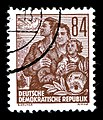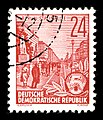Karl-Marx-Allee
You can helpexpand this article with text translated fromthe corresponding articlein German.(May 2021)Click [show] for important translation instructions.
|
This articleneeds additional citations forverification.(May 2021) |


Karl-Marx-Allee(English:Karl Marx Avenue) is aboulevardbuilt by theGDRbetween 1952 and 1960 inBerlinFriedrichshainandMitte.Today the boulevard is named afterKarl Marx.It should not be confused with theKarl-Marx-Straßein theNeuköllndistrict of Berlin.
The boulevard was namedStalinalleebetween 1949 and 1961 (previouslyGroße Frankfurter Straße), and was a flagship building project of East Germany's reconstruction programme afterWorld War II.It was designed by the architectsHermann Henselmann,Hartmann,Hopp, Leucht, Paulick, and Souradny to contain spacious and luxurious apartments for workers, as well as shops, restaurants, cafés, a tourist hotel, and an enormous cinema, theKino International.
The avenue, which is 89 metres (292 ft) wide and nearly 2 kilometres (1.2 mi) long, is lined with monumental eight-story buildings designed in thewedding-cake style,thesocialist classicismof theSoviet Union.At each end are dual towers atFrankfurter Torand Strausberger Platz designed byHermann Henselmann.The buildings differ in the revetments of the facades which contain often equally, traditional Berlin motifs byKarl Friedrich Schinkel.Most of the buildings are covered byarchitectural ceramics.
By 1989 half the tiles on the outer facades of these buildings had fallen off,[1]necessitating sheltering structures over the sidewalks in some places to protect pedestrians.[citation needed]
A monumentalStalin statuepresented to the East German government by aKomsomoldelegation on the occasion of the ThirdWorld Festival of Youth and Studentswas formally dedicated on 3 August 1951 after being temporarily placed at a location on the newly designed and impressive boulevard. It remained there until 1961 when it was removed in a clandestine operation in the course ofde-Stalinization.
On 17 June 1953 the Stalinallee became the focus of aworker uprisingwhich endangered the young state's existence. Builders and construction workers demonstrated against the communist government, leading to a national uprising. The rebellion was crushed with Soviet tanks and troops, resulting in the deaths of 125 people.[citation needed]
Later the street was used for East Germany's annualMay Dayparade, featuring thousands of soldiers along with tanks and other military vehicles to showcase the power and the glory of the communist government.
De-Stalinizationled to the renaming of the street, after the founder ofMarxism,in late 1961. Since the collapse of Eastern European communism in 1989/1990, renaming the street back to its prewar nameGroße Frankfurter Straßehas periodically been discussed, so far without conclusive results.
The boulevard later found favour withpostmodernists,withPhilip Johnsondescribing it as 'true city planning on the grand scale', whileAldo Rossicalled it 'Europe's last great street.'[2]SinceGerman reunificationmost of the buildings, including the two towers, have been restored.
Shopping
[edit]After its completion in the 1950s, the boulevard was very popular with Berliners and visitors alike. People crowded into the stores. "Taking theE lineto the shops on Stalin Boulevard "was not only a catchy slogan, it was also characteristic of everyday life in the East German capital. People could find things they would not see elsewhere, and the shopping facilities set an example for the whole of the GDR. The shops offered great variety and were attractively decorated. People could relax in cafés such asSybylleor at theKosmoscinema, and in the evening they could take their guests to one of the representative restaurants with such sonorous names asWarschau(Warsaw),Bukarest(Bucharest) (notable for its 18% alcohol Romanian beer), orBudapest.[3]
The boulevard soon developed into a shoppers' paradise in the GDR. It also served the ideological function of introducing visitors to the culture of its "socialist sister states".[3]Shopping was a mixed experience for visitors from the West. Most stores would not accept payment for purchased items without a receipt from an East German bank showing that theWest German Markshad been exchanged forEast German Marksat a rate of 1:1. In the West, the exchange rate was 1:8 but most restaurants and bookstores were not concerned with these requirements so bargains were to be found.
"Stalin's bathroom"
[edit]In February 2009, an anonymous author edited the article "Karl-Marx-Allee" in the German-language edition ofWikipedia,claiming that during the time of the GDR the road had acquired the nickname "Stalin's bathroom "due to the buildings' tiled façades. Subsequently, several media outlets reiterated this claim.[4][5][6]No alternative verification for the term was given, making it aself-referential claim.
After a letter written to theBerliner Zeitungquestioned whether the term "Stalin's bathroom" had actually been in common use during the GDR period,[7]Andreas Kopietz, a journalist at the newspaper, published an article admitting he had invented the phrase and identifying himself as the original anonymous Wikipedia editor, allowing the record to be set straight.[8]
In popular media
[edit]The boulevard is referenced under its former name, the Stalinallee, in thesatirical poem"Die Lösung"byBertolt Brechtabout theEast German uprising of 1953.
Photographs
[edit]-
Domed Tower at Frankfurter Tor
-
Façade of a Stalinist era apartment bloc
-
Façade of a Stalinist era apartment bloc
-
Façade detail
-
Karl-Marx-Allee looking towards the Berlin TV Tower.
-
Strausberger Platz, near the western end of the boulevard
-
Karl-Marx-Allee with Frankfurter Tor andTelevision Tower
-
Closeup of a Stalinist era building
-
Stalinallee, 1950
-
Stalinallee, 1959
-
"5-year Plan" postage stamp series, 1953: A family standing before a high-rise near the Weberwiese subway station
-
Berlin, Stalinallee
-
Trabantson Karl-Marx-Allee
-
Aerial view over Karl-Marx-Allee, 2019
See also
[edit]- Stalinist architecture
- Seven Sisters (Moscow)
- TheStraße der Pariser Kommune(street of theParis Commune) connects with Karl-Marx-Allee
References
[edit]- ^"Stalinallee: Palaces for the workers".Visit Berlin.Berlin Tourismus & Kongress GmbH.Retrieved2 July2022.
- ^Ladd, Brian (1998).The Ghosts of Berlin: Confronting German History in the Urban Landscape.Chicago: University of Chicago Press. p. 187.ISBN978-0-226-46762-7.
- ^ab"Karl-Marx-Allee, Berlin, information board | Flickr - Photo Sharing!".Flickr. 2012-12-11.Retrieved2014-02-04.
- ^Das längste Baudenkmal Europas[The longest monument in Europe] inBerliner Morgenpost.1 March 2011.
- ^"Viel Platz, wenige Kunden".MOZ.de.Retrieved2014-02-04.
- ^"Nachrichten"[News] (in German). BerlinOnline.de. 2011-02-25.Retrieved2014-02-04.
- ^"Nachrichten"[News] (in German). BerlinOnline.de. 2011-03-01.Retrieved2014-02-04.
- ^"Nachrichten"[News] (in German). BerlinOnline.de. 2011-03-24. Archived fromthe originalon 2011-09-05.Retrieved2014-02-04.
External links
[edit]![]() Media related toKarl-Marx-Allee (Berlin)at Wikimedia Commons
Media related toKarl-Marx-Allee (Berlin)at Wikimedia Commons















